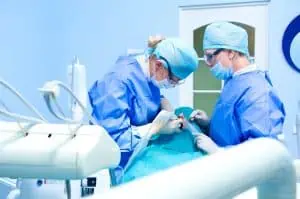Laser gum surgery is a way to treat gum disease. It uses lasers instead of a scalpel and therefore doesn’t require your gums to be cut like with traditional gum surgery. The result is a less invasive treatment that heals faster and hurts less.
In this article, we’ll talk all about laser gum surgery, including its pros and cons, the recovery process, and laser gum surgery costs. That way, you can figure out if this treatment is right for you.
Laser gum surgery is also called LANAP laser gum treatment or LANAP therapy, so you will see these terms used interchangeably throughout the article.
In This Article
What is laser gum surgery?
Laser gum surgery is a minimally invasive procedure that, as the name suggests, uses a laser to remove bad bacteria and damaged gum tissue from the gum pockets in order to treat gum disease.
Gum disease is most prevalent in adults above the age of 30 and can be caused by a number of different factors, including genetics, chronic illnesses, smoking, some medications, and poor oral health.
To stop periodontal disease, and even in some cases to reverse the damage, the harmful bacteria can be removed from the gums. Common techniques for this include scaling and root planing, as well as gum surgery.
All of these help to remove the buildup of plaque and calculus that may be causing a patient’s gum disease.
Laser gum surgery vs traditional gum surgery

Laser treatment for gum disease is much less invasive than traditional gum surgery. With traditional gum surgery, the process is typically as follows:
- Patient receives anesthesia
- Gums are cut open
- The affected area is cleaned and harmful bacteria removed
- The area is sewn up
This traditional treatment method is still very beneficial and a great option for many patients, but it has a few downsides, including greater discomfort or pain when healing.
Laser gum surgery doesn’t require the dentist to cut the gum tissue open and suture the area closed again. Another benefit is that the laser is precise enough to only target bad tissue; with traditional surgery, some healthy tissue is often lost as well.
LANAP for gum contouring
While LANAP is typically used to treat periodontal disease, it also serves cosmetic purposes. People who have a ‘gummy smile’ when there is an overgrowth of gingival tissue may not like the look of their gums. In this case, LANAP can be used for gum contouring.

There is also the concern that overgrown gum tissues can increase the risk of gum disease because there’s more room for bacteria and tartar to build up beneath the gum line, in which case LANAP can be used as a preventative measure.
Benefits of LANAP for gum disease
There are numerous benefits of using laser gum surgery for gum disease treatment. Let’s have a look at the most important:
- Tailored to patients: The wavelengths and power levels of the laser used in treatment can be adjusted depending on each individual patient’s level of gum disease. Dentists can customize the process to their patients for a more successful outcome.
- Less bleeding: The lasers used in LANAP remove and kill the bacteria from gingival pockets, which reduces gum swelling and bleeding. With the elimination of this bacteria, patients are less likely to need gum surgery afterwards.
- Minimally invasive: Lasers are more accurate and less invasive than traditional gum surgery. This means that there is a shorter recovery time and that patients will have less anxiety going into treatment. There’s also virtually no need for anesthesia.
- Protects healthy teeth: Lasers are very precise, which means that they can remove unhealthy bacteria without harming the healthy parts of teeth.
LANAP risks

As with any medical procedure, there are risks, although very few, of laser gum surgery. Here are some LANAP risks you may want to discuss with your dentist before treatment:
- User error: It’s essential to ensure that your periodontist has the training and skills required to operate a laser in this setting. Incorrect heat settings could cause more damage to gum tissue.
- Damage to tooth surface: Some laser gum treatments have resulted in cracking on the surface of the tooth or even the root.
- Tissue damage: It’s possible to experience cell death around the treated area.
Does LANAP work?
LANAP laser gum therapy works for many people, whether it’s for the treatment of gum disease, gum contouring for longer-looking teeth and a more aesthetic smile, or the prevention of gum disease.
LANAP therapy, however, is not suitable for everyone, especially if your case of periodontitis is too severe. During your consultation with your periodontist, they will let you know if you are a good candidate for this treatment.
Does laser gum surgery hurt?

One of the benefits of laser gum surgery compared to traditional gum surgery is that there is virtually no pain. While anesthesia is necessary for normal gum surgery, for LANAP it rarely is.
After surgery, you’re likely to experience less pain than you would with traditional surgery because there are no stitches involved and the healing time is generally faster.
Laser gum surgery procedure
Now let’s have a look at what you can expect from the actual LANAP procedure:
- Measure pockets: Your dentist will use a special instrument to measure the depth of your periodontal pockets to determine the degree the gum has become detached from the tooth.
- Laser placement: The dentist will position the laser’s fiber-optic tip at the top of the periodontal pocket.
- Bacterial removal: The laser will destroy the infected tissue and remove and kill any bacteria below the gum line. Because the laser is so precise, it can selectively remove damaged tissue without harming healthy tissue.
- Tartar removal: Your dentist will use an ultrasonic cleaning tool to remove tartar and calculus that has formed beneath the gum line.
- Clotting: The laser removes the remaining bacteria and helps the blood form a seal around the now clean periodontal pocket. This stops new germs from getting in and helps the body heal faster. Plus, no stitches are needed.
The entire process can usually be completed within a 2-hour appointment. After the surgery, your dentist may conduct a bite check and adjust your bite if needed, eliminating further damage to your teeth.
Patients should experience very little discomfort during and after the procedure.
Laser gum surgery recovery
Because there are no incisions or stitches involved in LANAP laser gum surgery, recovery is easier than it would be with traditional gum surgery.
In fact, once the surgery finishes, your body begins the healing process and you may even be able to get back to life as usual the next day. However, everyone is different and some people may need a few days to feel better.
Some things that you can expect over the next few days include the following laser gum treatment surgery side effects:
- Slight swelling
- Some bleeding
- Gum discoloration
These aren’t bad signs; it just means that your body is sending more blood to those areas in order to aid in repair.
Your dentist will also recommend that during LANAP surgery recovery you don’t brush or floss the treated area during the next week or so; however, you should continue to brush and floss as normal in the unaffected areas of your mouth — just make sure to do it extra carefully.
Your dentist will give you specific instructions that you should follow, but in general they will include the following:
- Don’t brush or floss the affected area
- Rinse your mouth gently, but don’t spit — instead, let the water fall out of your mouth
- Stick to soft foods
- Don’t smoke or use nicotine
Laser gum surgery healing time will usually only take a week to 10 days.
Laser gum surgery cost
LANAP costs will vary depending on the patient, but you can expect to pay anywhere between $1,000 and $4,000. The good news is that if you have dental insurance and you need laser gum surgery for a medical reason, insurance will most likely help cover the costs.
The cost of laser gum surgery will depend on the following factors:
- If it’s covered by your dental insurance
- The severity of your gum disease
- The technology used by your dentist
- Where your dentist is
- Additional services
LANAP reviews
The following video shows one patient’s review of her LANAP surgery. She decided to get laser gum treatment because she had sore and bleeding gums from her gingivitis.
She says that during the treatment there was some slight pain, but that now she has no more bleeding or swelling and the aesthetics of her smile have improved as well.
LANAP dentist near me
To get this type of laser gum surgery, you need to find a dentist that is certified in the procedure. If you need help finding a LANAP dentist near you, you can call 866-383-0748.
If there’s a LANAP dentist in your area, you’ll get to talk with them and set up a time for a consultation.
Laser treatment for gum disease pros and cons
Before you go, let’s have a quick look again at the pros and cons of laser treatment for gum disease vs traditional treatment so you can figure out if this treatment is the best option for you:
Laser Surgery | Traditional gum surgery | |
The gum doesn't need to be cut | Gum tissue is cut and removed | |
Sutures | There are no stitches needed | Stitches are needed |
Bleeding | Only slight post-operative bleeding | Post-operative bleeding is more common |
Gum tissue | This also preserves the gum between the teeth | Can leave large spaces between teeth |
Recovery | You can be back to your usual activities the next day | Recovery takes much longer |
While the pros and cons certainly skew positively toward laser gum surgery, that isn’t to say that traditional gum surgery isn’t a successful treatment as well.
The most important thing is to make sure you get your gum disease treated in the way that your periodontist recommends. And if your gum disease is too far advanced, laser surgery may not be an option for you.
Conclusion

Laser gum surgery is a non-invasive treatment for gum disease. It’s becoming more popular because of its numerous benefits compared to traditional gum surgery — less pain, faster healing time, and less invasive.
Also called LANAP, this treatment can also be used for gum contouring, whether to improve the appearance of a gummy smile or to prevent gum disease in the future.
Not everyone is a candidate for laser gum surgery, especially those whose gum disease is too far advanced. Your periodontist will be able to recommend the best course of treatment for your particular case.
3 Ways To Finance Dental Work That Aren’t Insurance
FAQs
How much does laser gum treatment cost?
Laser gum treatment costs anywhere from $1,000 to $4,000. The cost will vary depending on where your dentist is located, what technology they use, and the severity of your case.
How much does LANAP cost?
LANAP is the same as laser gum treatment and costs anywhere from $1,000 to $4,000. If you need LANAP for medical reasons, it’s likely to be partially covered by your insurance.
Is laser gum surgery worth it?
If you are eligible and you have gum disease, laser gum surgery is likely worth it for you. It’s essential to get gum disease treated, and your dentist will discuss your best options with you.
Open Dentistry Journal: Latronic Damage to the Periodontium Caused by Laser: An Overview. Consulted 9th July 2021.
CDC: What is Periodontal Disease. Consulted 10th July 2021.




